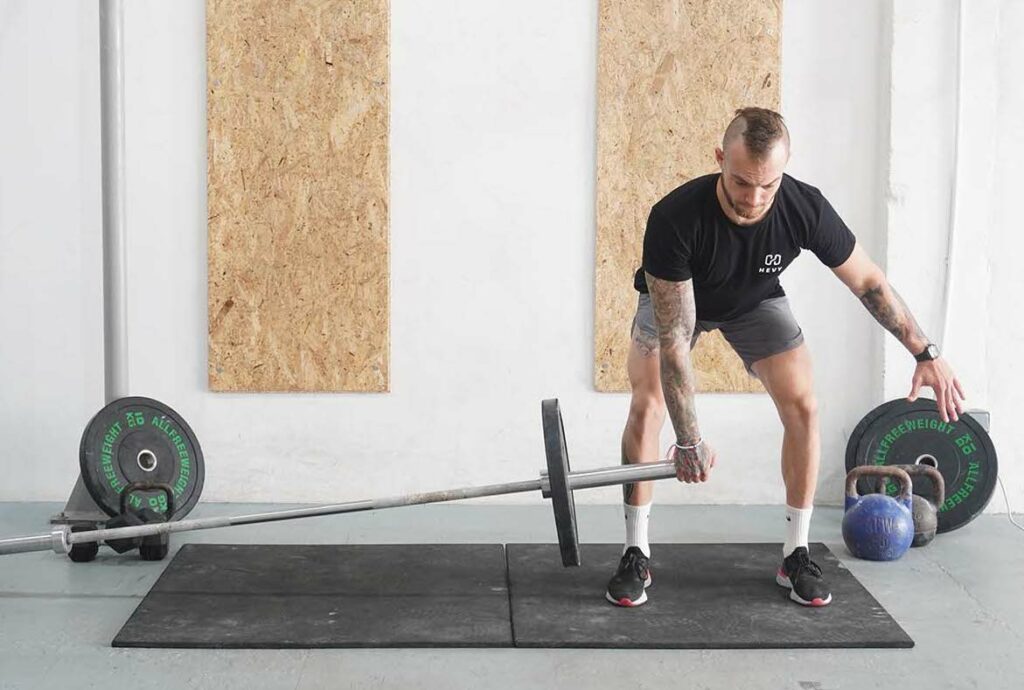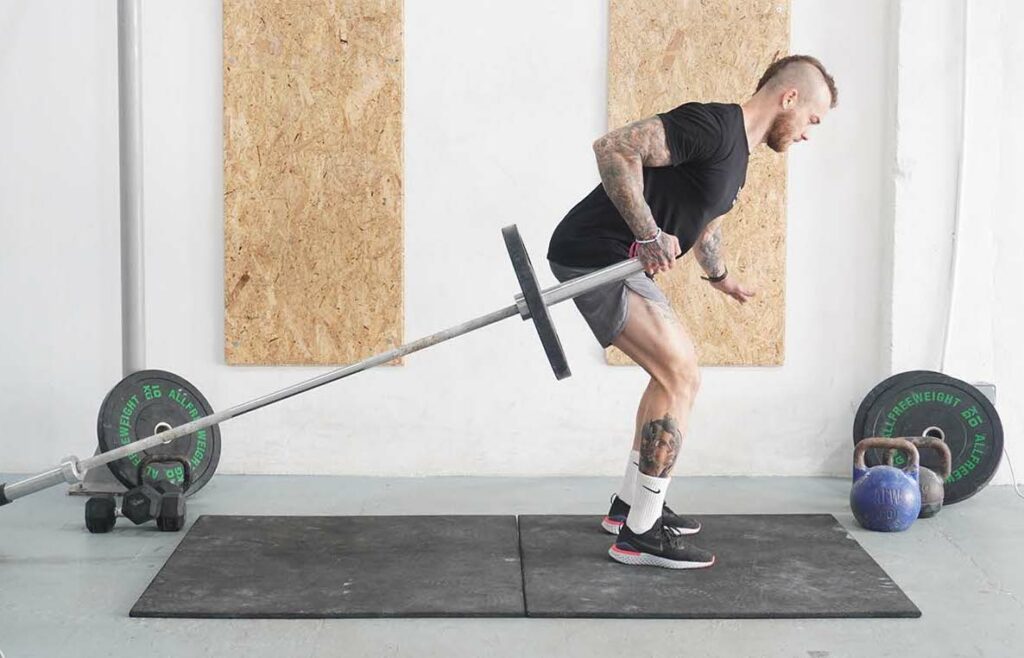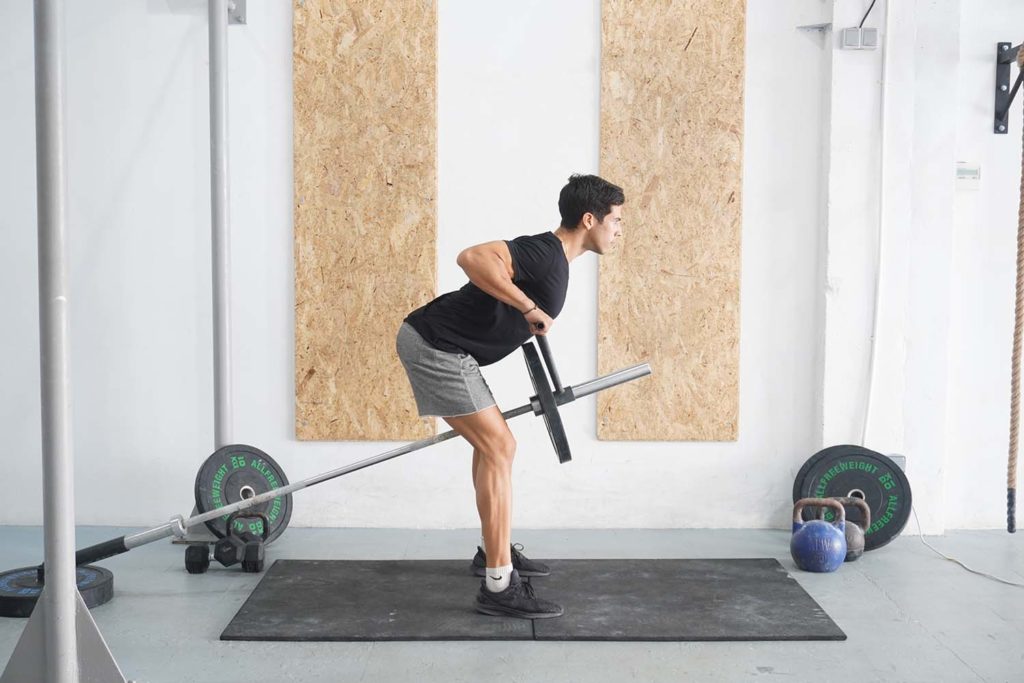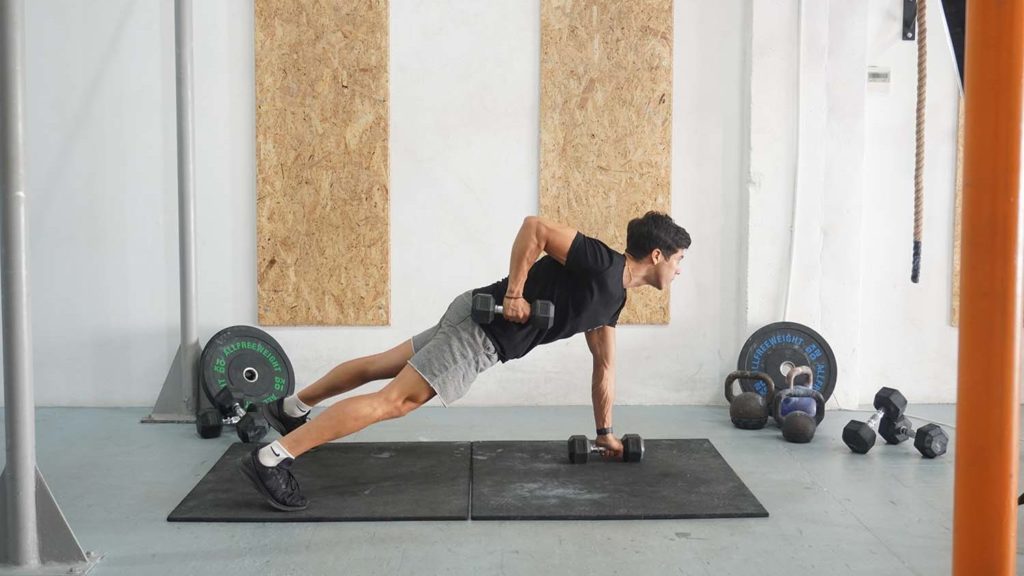The Benefits of the Barbell Meadows Row
Meadows rows are an effective unilateral landmine exercise that strengthens the back. The movement is named after the late John Meadows, who played a massive role in popularizing it among bodybuilders.
The Meadows row is slightly unorthodox because you have to anchor one end of the barbell inside a landmine attachment, go to the opposite side, and have your feet perpendicular to the barbell. Instead of grabbing the bar itself, you must hold onto the barbell sleeve––the thicker part where weight plates go. Meadows rows are designed to develop your upper back, beneficial for good posture and spinal alignment.
A notable benefit of Meadows rows is the fantastic overloading potential. The movement works as an accessory for back development, but you can add a respectable amount of weight to the bar and cause significant overload.
Another benefit of the movement is that it strengthens your grip well because you must hold onto the barbell sleeve, which is thicker and more challenging to support.
Meadows rows work well in almost any workout plan. You can perform the exercise with a lighter weight for more repetitions or use a heavier load and do fewer reps. We recommend including Meadows rows near the middle of your training and using a moderately-heavy load for at least ten reps per side on each set.
Level of Exercise: Intermediate
How to do a Barbell Meadows Row

- Set a standard barbell on a landmine attachment or place one end of the bar at a wall angle to serve as an anchor point.
- Load the opposite side of the barbell with at most 15 lbs.
- Stand perpendicular to the loaded side of the bar (one side facing it).
- Assume a staggered stance, bend forward, and grab the barbell sleeve with the hand closer to the bar.
- Raise your torso enough for the loaded side of the barbell to lift an inch or two off the floor while your arm is straight.
- Bring your shoulders back, take a breath, and pull the bar up and close to your side, squeezing your lat. Pull the weight until your elbow is at a 90-degree angle and the barbell sleeve is at torso level.
- Hold the top position for a moment and extend your arm slowly, exhaling on the way down. Don’t protract your shoulder (roll it forward) as you reach the bottom of each rep.
- Take another breath and repeat.
Once finished training one side, rotate your body 180 degrees, grab the barbell sleeve with your opposite hand, and perform the same number of slow and controlled repetitions.
What muscles does the Meadows row activate?
The primary muscle group that works during Meadows rows is the latissimus dorsi (lats)––the largest and most powerful muscle in the upper body. Our lats cover a large percentage of the middle and upper back and contribute to numerous arm motions (1). The muscle group produces a lot of force for us to row the weight up.
Our biceps are the second major muscle group with an active role during Meadows rows. The muscle covers the front side of our upper arms, and its primary function is elbow flexion (bending the arm) (2). Along with the lats, our biceps produce the necessary force to create elbow flexion, allowing us to row the barbell. Similarly, the brachialis, which lies underneath the biceps, assists in elbow flexion (3).
The trapezius (traps) is another muscle with a significant role during Meadows rows. Our traps make up the bulk of the mid and upper back and contribute to shoulder health, scapular stability, and neck extension (4). In addition, the muscle group promotes torso stability during Meadows rows, allowing us to perform the movement safely and effectively.
Other upper back muscles, including the rear deltoids, rhomboids, infraspinatus, and erector spinae, also work during the movement. Their primary functions relate to torso stability and scapular retraction. Similarly, our midsection musculature flexes isometrically to keep us stable as we row.
Tips on Proper Form when Preforming the Meadows Row
Tip 1
Picking the appropriate load and training with a full range of motion. The weight you choose should allow you to perform at least ten smooth and controlled reps. In addition, you should be able to extend your arms fully and row the weight to the top position in one fluid motion.
Tip 2
Assume a staggered stance by bringing one foot forward and the other slightly back. Doing so creates a larger base, allowing you to maintain balance and row more weight with proper form.
Tip 3
Maintaining tightness in your abs as you do repetitions. The abs shorten the distance between the pelvis and ribcage when engaged, creating a natural spine curve. Keeping these muscles tense allows you to maintain a neutral spine and prevent excessive arching that can cause unnecessary stress.
Tip 4
Consider using a false grip––not wrapping your thumb around the barbell sleeve. Doing so might be beneficial for activating your back muscles more effectively instead of having your biceps do all the work.
Tip 5
Perform each repetition slowly and with good control. Avoid using momentum because that robs your muscles of tension, making each repetition less effective, even if you’re using more weight.
Variations and Modifications of the Meadows Row
1. Single-Arm Landmine Rows

Single-arm landmine rows are similar to Meadows rows because you use the same configuration. But, instead of standing perpendicular to the barbell and grabbing the sleeve, you’re parallel and holding the bar itself (the thinner area) right underneath the sleeve. The exercise resembles dumbbell rows and offers similar benefits and identical muscle activation to Meadows rows.
2. Pause Meadows Rows
Pause Meadows rows are a beneficial variation you can perform to clean up your technique and improve muscle activation. Doing so is helpful for people who struggle to activate their back muscles and overwork their biceps instead. Set yourself up for the movement, row, and hold the top position for two to three seconds before releasing.
3. Tempo Meadows Rows
Like pause Meadows rows, the tempo variation works well for people looking to improve their training form and activate their back muscles better. As with any tempo variation of an exercise, the objective is to lift and lower the weight slightly longer and include a slight pause at the top. Doing so forces you to use a load you can control and prevents you from jerking the weight and using momentum.
Mistakes to Avoid
Using too Much Weight
The most common variation with most rowing exercises is using too much weight. Trainees often overestimate the amount of weight they can lift with proper technique, leading to poor form, a shorter range of motion, and the use of momentum. While lifting more weight might make you feel better, it often comes at the expense of poor training results. Instead, you should pick a weight you can handle for at least ten smooth and controlled repetitions. Lifting lighter weight with better technique promotes muscle activation and brings much better results in the long run.
Protracting Your Shoulder Blades
The second common error with the Meadows row is protracting your shoulder blades as you extend your arms on the way down. As the weight moves down and your elbow extends, your shoulder rolls forward, causing upper back roundness. Doing so isn’t necessarily fatal, but it makes your sets less efficient, forcing you to use more energy because you must retract your shoulder before each new repetition. A much better approach is to bring your shoulders back, keep your abs engaged, and maintain that position as you bend and extend your elbows.
Using Large Plates
Stronger people are more likely to load larger plates on the barbell because that’s more efficient. Why put four 10-lb plates when you can put a single 35 or 45-lb one? The problem with larger plates during Meadows rows is they get in the way and can shorten your range of motion. As a result, you won’t be able to squeeze your back muscles as effectively near the top position. A much better but more annoying approach is to load smaller plates––as small as 10 lbs. That way, you can still load the barbell and overload your muscles, but the smaller plates won’t get in your way.
Similar Exercises to the Meadows Row
Dumbbell Row

Dumbbell rows are a fantastic accessory exercise that strengthens the same muscles as Meadows rows. When done correctly, the single-arm dumbbell row emphasizes your lats and works the trapezius, rhomboids, infraspinatus, rear deltoids, erector spinae, biceps, and brachialis. Like Meadows rows, you train one side at a time through a similar range of motion. You’re also using many of the same cues (e.g., abs tight, shoulders retracted, neck neutral, etc.).
T Bar Row

T bar rows are another accessory back exercise that overloads and develops your upper body musculature. One option is to perform the movement on a T bar station. Alternatively, you can anchor a barbell with a landmine attachment and use a V bar attachment to hold the bar and keep it between your legs as you row. The range of motion is similar to that of Meadows rows, and you’re training the same muscle groups.
Renegade Row

Renegade rows are more of a functional exercise that trains your back and biceps while improving your core strength. The objective is to assume a push-up position with a hexagonal dumbbell in each hand, and you must tilt slightly to one side and row the opposite dumbbell repeatedly. Renegade rows offer a similar range of motion to Meadows rows and train many of the same muscle groups.

